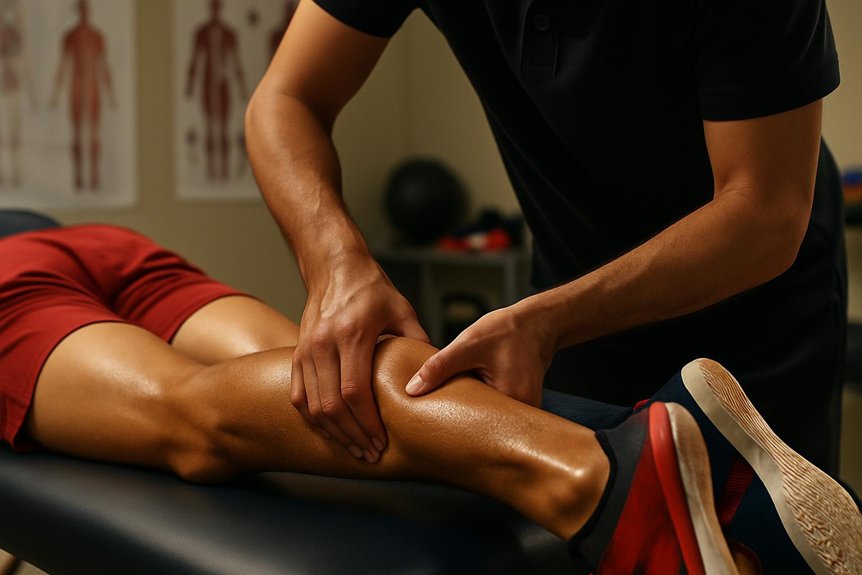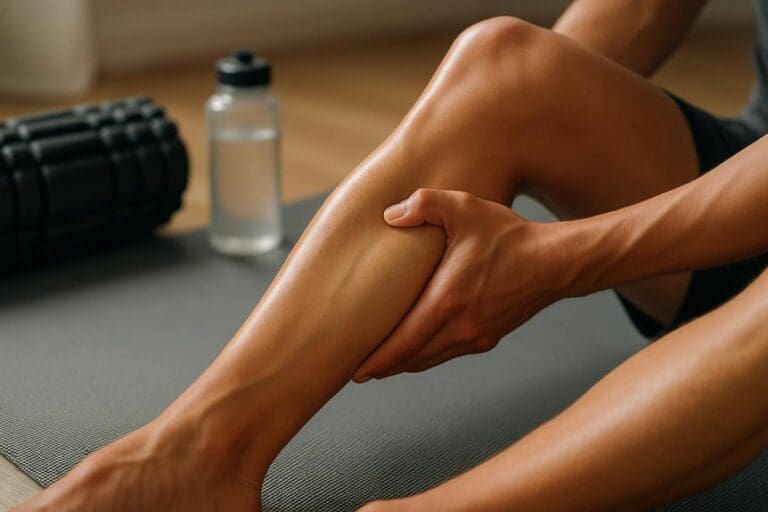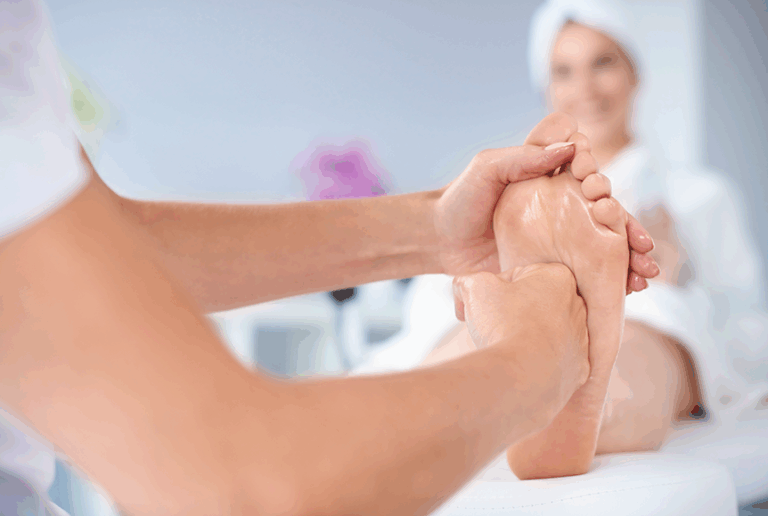A athletic recovery massage is an evidence-based manual therapy tailored to athletes and active individuals, employing techniques like effleurage, petrissage, myofascial release, and assisted stretching. It focuses on addressing musculoskeletal imbalances, enhancing recovery, and preventing sports-related injuries. Sessions are individualized, emphasizing biomechanical assessments, recovery acceleration, and performance optimization. Distinct from general relaxation massage, it integrates clinical knowledge to support tissue repair and functional mobility. Further insights illuminate its unique benefits, underlying principles, and practical applications for performance and recovery.
Understanding the Principles of this Massage

Performance therapy is a specialized intervention targeting musculoskeletal health, specifically designed to address the needs of physically active individuals. Unlike general relaxation or holistic massage, sports massage employs advanced techniques—such as effleurage, petrissage, friction, and myofascial release—to focus on areas of tension, overuse, or injury.
At Spa & Massage, therapists conduct detailed assessments to identify muscle imbalances, restricted range of motion, and soft tissue adhesions. Each session is tailored to the client’s activity profile and current physical state, prioritizing evidence-based protocols for ideal tissue recovery and function.
The approach is both systematic and responsive, providing a focused, therapeutic experience that integrates clinical knowledge with attentive, hands-on care to support musculoskeletal well-being. While athletic recovery massage is distinct, some wellness practices—such as those found in the healing power of reflexology—also emphasize targeted touch to promote overall balance and recovery.
Key Benefits for Athletes and Active Individuals
A targeted performance therapy delivers clinically validated benefits for athletes and physically active individuals by enhancing musculoskeletal recovery, reducing delayed onset muscle soreness (DOMS), and facilitating ideal tissue repair. This intervention modulates local circulation, promoting nutrient delivery and metabolic waste removal, which expedites cellular regeneration.
At Spa & Massage, therapists apply evidence-based protocols that address microtrauma from intensive exercise, thereby attenuating inflammation and restoring functional mobility. Regular massage session contributes to improved flexibility, joint range of motion, and neuromuscular efficiency—key factors in injury prevention and athletic performance optimisation.
Many clients report a greater sense of embodiment, reduced tension, and improved psychological readiness. By integrating this massage into a structured training regimen, individuals receive holistic support, aligning physical resilience with a sense of personal wellbeing and renewed vitality.
Common Techniques Used
While athletic recovery massage encompasses a diverse array of manual interventions, practitioners at Spa & Massage employ a core set of clinically validated techniques to address the unique demands of active individuals.
Effleurage, characterized by smooth, gliding strokes, is often utilized to promote circulation and facilitate relaxation of superficial musculature.
Petrissage, involving kneading and compression, targets deeper muscle layers to enhance tissue pliability and reduce adhesions.
Friction techniques are applied with precision to disrupt scar tissue and restore ideal muscle alignment.
Additionally, tapotement—rhythmic percussion—stimulates neuromuscular responsiveness.
Myofascial release and assisted stretching are frequently incorporated to improve flexibility and functional range of motion.
Each intervention is tailored to the client’s presenting condition, guided by ongoing assessment and the therapist’s expert palpation skills at Spa & Massage.
How This Therapy Differs From Other Massage Types
This is distinguished from other modalities by its targeted application of focused muscle techniques, specifically designed to address the biomechanical demands of physical activity.
At Spa & Massage, therapists employ evidence-based protocols that emphasize injury prevention and functional recovery.
This approach supports enhanced tissue repair, optimizes performance outcomes, and mitigates risk of future musculoskeletal dysfunction.
Focused Muscle Techniques
Distinct from general relaxation or wellness massage modalities, this massage employs focused muscle techniques specifically designed to address the functional demands placed on the musculoskeletal system. Therapists at Spa & Massage utilize targeted methods such as deep tissue manipulation, myofascial release, and neuromuscular techniques, all supported by contemporary evidence in manual therapy.
These interventions are meticulously applied to specific muscle groups experiencing heightened tension, overuse, or restricted range of motion. Each technique is tailored to anatomical considerations and the unique needs of the individual, fostering a sense of attentive care.
Injury Prevention Approach
A primary differentiator between this massage and other massage modalities is its proactive focus on injury prevention. Athletic recovery massage employs targeted manual techniques designed to identify and address muscular imbalances, fascial restrictions, and areas of heightened tension before they progress into injuries.
At Spa & Massage clinics, therapists conduct thorough musculoskeletal assessments to tailor interventions that enhance tissue resilience and functional integrity. By integrating deep tissue manipulation with neuromuscular facilitation, therapists help to optimise muscle elasticity and joint mobility, consequently mitigating the risk of strains and overuse syndromes common in active individuals.
This prevention-focused approach contrasts with relaxation-based styles, which typically prioritise short-term relief. The result is a therapeutic experience that fosters trust and supports clients’ long-term wellbeing, aligning with Spa & Massage’s commitment to holistic care.
Recovery and Performance Benefits
Beyond its preventative focus, this modality is uniquely positioned to expedite recovery and enhance athletic performance. Performance therapy employs targeted techniques such as myofascial release, deep tissue manipulation, and trigger point therapy to reduce delayed onset muscle soreness (DOMS), accelerate lactic acid clearance, and promote ideal tissue regeneration.
Unlike relaxation or aromatherapy massage, its clinical intent prioritizes functional outcomes—restoring range of motion, reducing inflammation, and facilitating neuromuscular efficiency.
At Spa & Massage, therapists meticulously tailor each session to the client’s training regimen and recovery goals, often integrating specialized oils that promote circulation and reduce swelling. This evidence-based approach supports both elite and recreational athletes in London, ensuring that recovery is not merely passive rest, but an active process that sustains peak physical performance.
When to Book a Session
Optimal timing for athletic recovery massage varies according to specific goals, including pre-event muscle preparation, post-exercise recovery, and injury management.
Evidence indicates that scheduling sessions at appropriate intervals can enhance performance, reduce delayed onset muscle soreness, and support rehabilitation.
At Spa & Massage, therapists assess individual needs to recommend the most effective timing for each client.
Pre-Event Preparation Timing
When preparing for a sporting event, timing of a performance therapy is essential for achieving desired physiological effects. Pre-event in this massage is ideally scheduled within 24–48 hours prior to competition.
At Spa & Massage clinics, therapists focus on invigorating techniques designed to elevate circulation, enhance neuromuscular readiness, and reduce muscular tension without inducing post-treatment soreness. This strategic scheduling allows the body to benefit from increased tissue elasticity and improved range of motion while avoiding fatigue.
Therapists at Spa & Massage carefully tailor the session length and intensity to the athlete’s specific needs and sport, ensuring an energising, supportive experience. Clients are advised to communicate event times and personal goals, allowing the therapist to optimize both timing and technique for peak performance readiness.
Post-Workout Recovery Benefits
A well-timed athletic recovery massage following physical activity can substantially accelerate post-workout recovery by facilitating metabolic waste removal, reducing delayed onset muscle soreness (DOMS), and restoring ideal muscle function.
At Spa & Massage, therapists employ targeted techniques such as effleurage, petrissage, and myofascial release to enhance circulation and lymphatic drainage, promoting more efficient tissue oxygenation and nutrient delivery.
This intervention helps the body effectively clear lactic acid and other byproducts that accumulate during exertion, supporting a quicker return to baseline performance levels.
Many clients report a noticeable decrease in muscular tension and a greater sense of bodily ease after treatment.
For those seeking to optimise their recovery process, scheduling a athletic recovery massage within 24 to 48 hours post-exercise is clinically recognised as most beneficial.
Injury Management Considerations
How does timing influence the effectiveness of performance therapy in injury management? Clinical evidence underscores that the strategic scheduling of massage is critical to ideal recovery and prevention of secondary complications.
Acute injuries typically require an initial period of rest, ice, compression, and elevation (RICE) before manual intervention.
At Spa & Massage, therapists advise clients to seek professional assessment prior to booking a session post-injury. Once acute inflammation has subsided, targeted athletic recovery massage can facilitate myofascial release, enhance circulation, and support tissue repair.
Early but appropriate intervention may reduce the risk of chronic adhesions and limited range of motion.
The therapists at Spa & Massage tailor their approach based on the injury phase, ensuring each client receives the right treatment at the right moment for effective, compassionate healing.
What to Expect During Your Appointment
Prior to commencing a massage appointment at Spa & Massage, clients undergo a brief consultation to assess individual needs, medical history, and specific areas of musculoskeletal concern. This initial evaluation allows the therapist to tailor each session, ensuring both safety and ideal therapeutic outcomes.
During the massage, targeted manual techniques such as effleurage, petrissage, and deep tissue manipulation are applied to address muscular tension, enhance circulation, and facilitate tissue recovery.
Communication remains integral; therapists encourage feedback regarding pressure and comfort, fostering a collaborative experience.
At Spa & Massage, privacy and client comfort are prioritised, with tranquil surroundings designed to promote relaxation and trust.
Sessions typically last between 30 to 90 minutes, depending on the client’s requirements and the treatment plan established during consultation.
Aftercare Tips for Lasting Results
Post-treatment care substantially influences the efficacy and longevity of massage outcomes. Evidence underscores the importance of adequate hydration to facilitate metabolic waste removal and optimise tissue recovery.
At Spa & Massage, therapists recommend gentle mobility exercises and light stretching within 24 hours post-session to maintain muscle elasticity and support neural adaptation.
Application of cold or heat packs, as clinically indicated, aids in modulating inflammatory responses and alleviating residual discomfort.
Clients are advised to monitor for delayed-onset muscle soreness and adjust physical activity intensity accordingly.
Nutritional support, particularly protein intake, is emphasised to enhance tissue repair.
Restorative sleep remains essential for neuromuscular regeneration.
These aftercare protocols, routinely emphasised by Spa & Massage, ensure clients experience sustained therapeutic benefit and foster a sense of connection to their ongoing wellness journey.
Conclusion
In summary, athletic recovery massage offers targeted therapeutic benefits for physically active individuals, improving flexibility, circulation, and recovery. Importantly, research indicates that regular massage can reduce delayed onset muscle soreness by up to 30% (Zainuddin et al., 2005). By employing evidence-based techniques, Spa & Massage guarantees each treatment is tailored for ideal musculoskeletal health. Individuals seeking enhanced performance or rehabilitation may find performance therapy a clinically effective adjunct to their wellness regimen.



